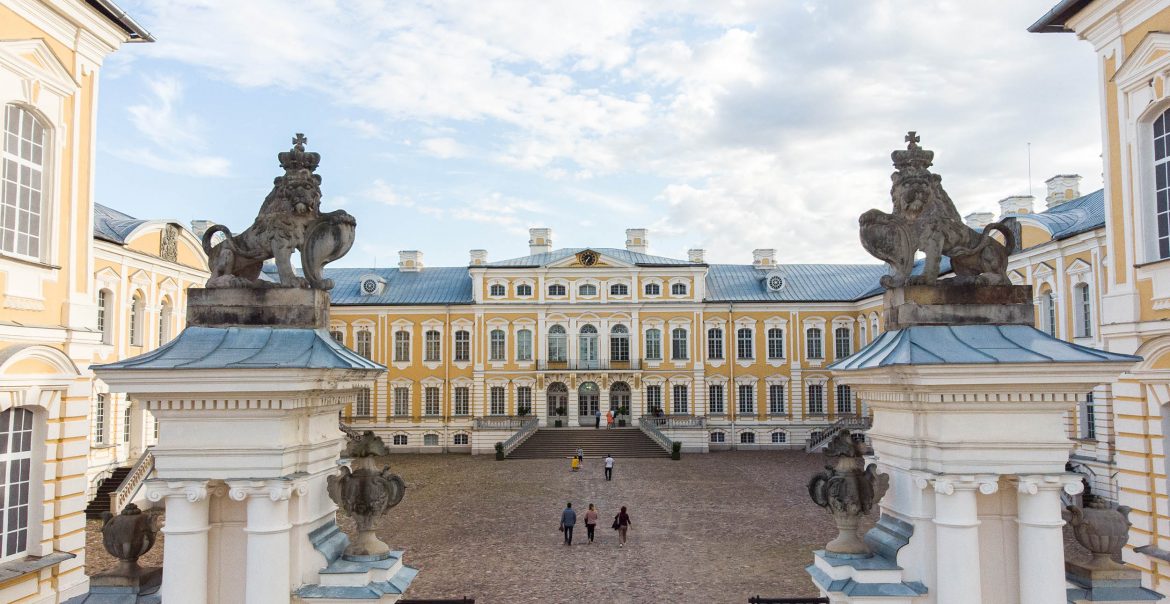In the summer of 2020, the Rundāle Palace Museum entered a submission ‘The Rundāle Palace Building Ensemble with a Garden and Forest Park’ for the nomination of the Latvian National Register of UNESCO World Heritage Sites. After an expert survey and evaluation of the nomination application, the Assembly of Latvian National Commission (LNK) for UNESCO resolved to include the Rundāle Palace ensemble in the Latvian National Register of UNESCO World Heritage Sites.
Rundāle Palace and its garden is a site where the ambitions of several outstanding people have met. On the one hand, it was the Duke of Courland Ernst Johann Biron who bought property in his native land and accomplished the idea of building a luxurious residence, designed by the best architect of the Russian Empire at that time. On the other hand, the talent of architect Francesco Rastrelli (1697–1771) was outstandingly expressed in the construction of the Rundāle Palace ensemble. He had the opportunity to build an ideal residence according to the dominant trends of his time, whilst also planning the garden area and its surrounding development. As a result, and as any visitor to the museum can attest, a representative and yet at the same time reasonably restrained building has been constructed that blends harmoniously with the surrounding landscape and forms a potentially familiar relationship between the scale and space that is comprehensible to all. Rundāle Palace is the only construction project by the Russian court architect Francesco Rastrelli, which took place in the early stages of his 20-year long career and has not undergone reconstruction during the 19th century or been destroyed in the revolutions and wars of the 20th century. Unlike many European palaces, Rundāle has preserved the stylistic integrity of 18th century architecture.
Rundāle Palace is currently presented as the Duke’s summer residence. The palace premises have been furnished with a fine selection of 18th century furniture, interior objects and works of art, thus enabling visitors to perceive the original function of the premises and creating an atmosphere of habitation corresponding to the Duke’s standard of living.
Setting its main task as the fulfilment of aspirations of the Baroque period for surprises and unexpected effects, one of the largest rosariums in the northern part of Europe has been established in the greenery of the French Garden of Rundāle Palace. The collection of roses, which includes more than 2300 varieties, showcases historical roses grown since the 12th century and the achievements of modern propagators. The layout of the garden bosquets has been renovated according to the historical network of pathways and green areas. Following Rastrelli’s plans, the Green Theatre was established in one of the garden bosquets.

‘We are very proud of the Rundāle Palace building ensemble and are convinced that it deserves international recognition not only as a unique example of Rastrelli’s early architecture, but also as aplace where the creative spirit of artists and gardeners has met, combining appreciation for the Baroque environment in such a way that is also accessible to people living in the present time. Of course, all of this has only been possible due to a purposeful and scientifically based restoration of the entire palace complex that has already lasted more than half a century’, explains the Director of the Rundāle Palace Museum Laura Lūse.
As part of continued efforts towards the UNESCO World Heritage List, the museum must expand on the scientific substantiation of its application for the universal value of the Rundāle Palace ensemble, and continue to uphold the palace in international circulation whilst maintaining the entire complex in accordance with the requirements for the protection of cultural heritage.
Heritage sites included in the Latvian National Register of UNESCO World Heritage Sites may potentially be nominated for inclusion in the international UNESCO World Heritage List. The decision to include heritage sites in the Latvian National Register of UNESCO World Heritage Sites is made by the Assembly, which is the highest decision-making body of the Latvian National Commission of UNESCO. Decisions to supplement the national register are made by the Assembly of Latvian National Commission of UNESCO, based on the opinion of the State Inspection for Heritage Protection, as a national institution responsible for heritage protection; the International Council of Monuments and Sites (ICOMOS) in Latvia, as a non-governmental organization of heritage professionals; as well as the opinion of independent experts. Local authorities and experts assessed that the nomination of Rundāle Palace had universal value within the context of Latvia and Europe and a high potential to meet the criteria, authenticity and integrity requirements set out in the guidelines of the UNESCO Convention Concerning the Protection of the World Cultural and Natural Heritage.


